Other uses
- Spy Hunter, a song by Christian rock band Project 86
- Samurai Spy , a 1965 film also known as Spy Hunter
- SpyHunter (security software), an anti-spyware program for Microsoft Windows
- Spyhunter, a book by Michael Shrimpton
Spy hunter may refer to:

Pac-Man, originally called Puck Man in Japan, is a 1980 maze action video game developed and released by Namco for arcades. In North America, the game was released by Midway Manufacturing as part of its licensing agreement with Namco America. The player controls Pac-Man, who must eat all the dots inside an enclosed maze while avoiding four colored ghosts. Eating large flashing dots called "Power Pellets" causes the ghosts to temporarily turn blue, allowing Pac-Man to eat them for bonus points.

Joust is an action game developed by Williams Electronics and released in arcades in 1982. While not the first two-player cooperative video game, Joust's success and polished implementation popularized the concept. Players assume the role of knights armed with lances and mounted on large birds, who must fly around the screen and defeat enemy knights riding buzzards.
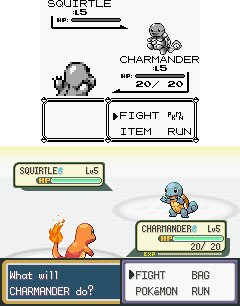
A video game remake is a video game closely adapted from an earlier title, usually for the purpose of modernizing a game with updated graphics for newer hardware and gameplay for contemporary audiences. Typically, a remake of such game software shares essentially the same title, fundamental gameplay concepts, and core story elements of the original game, although some aspects of the original game may have been changed for the remake.

Ms. Pac-Man is a 1982 maze arcade video game developed by General Computer Corporation and published by Midway. It is the first sequel to Pac-Man (1980) and the first entry in the series to not be made by Namco. Controlling the title character, Pac-Man's wife, the player is tasked with eating all of the pellets in an enclosed maze while avoiding four colored ghosts. Eating the larger "power pellets" lets the player eat the ghosts, who turn blue and flee.
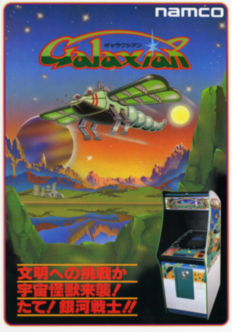
Galaxian is a 1979 fixed shooter arcade video game developed and published by Namco. The player assumes control of the Galaxip starfighter in its mission to protect Earth from waves of aliens. Gameplay involves destroying each formation of aliens, who dive down towards the player in an attempt to hit them.
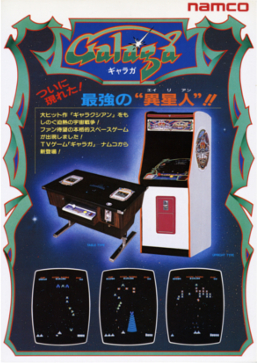
Galaga is a 1981 fixed shooter arcade video game developed and published by Namco. In North America, it was released by Midway Manufacturing. It is the sequel to Galaxian (1979), Namco's first major video game hit in arcades. Controlling a starship, the player is tasked with destroying the Galaga forces in each stage while avoiding enemies and projectiles. Some enemies can capture a player's ship via a tractor beam, which can be rescued to transform the player into a "dual fighter" with additional firepower.

Spy Hunter is a vehicular combat action game developed by Bally Midway and released for arcades in 1984. The game draws inspiration from the James Bond films and was originally supposed to carry the James Bond brand. The object of the game is to drive down roads in the technologically advanced "Interceptor" car and destroy various enemy vehicles with a variety of onboard weapons. Spy Hunter was produced in both sit-down and standard upright versions with the latter being more common. The game's controls consist of a steering wheel in the form of a futuristic aircraft-style yoke with several special-purpose buttons, a two-position stick shift, and a pedal used for acceleration.

Super Sprint is a racing video game released by Atari Games and Midway Games in 1986. Up to three players drive Formula One-like cars on a circuit that is viewed from above. The game is a successor to Gran Trak 10 and the Sprint series, which were black-and-white games from the 1970s. A sequel, Championship Sprint, was released later in the same year.

Midway Arcade Treasures is a video-game compilation of 24 arcade games, emulated from the original PCBs. The overall release was developed by Digital Eclipse and issued by Midway for the PlayStation 2, Xbox, GameCube, and Microsoft Windows.

SpyHunter is a vehicular combat game. It is a remake and sequel of the 1983 arcade game of the same name first released for PlayStation 2 in 2001. It has since been ported to GameCube, Xbox, Game Boy Advance, Microsoft Windows, OS X, and Tapwave Zodiac. In the game, the player drives the G-6155 Interceptor, an advanced, weaponized spy vehicle. Unlike the original's top-down view, the remake is played with a chase camera, similar to a racing game.
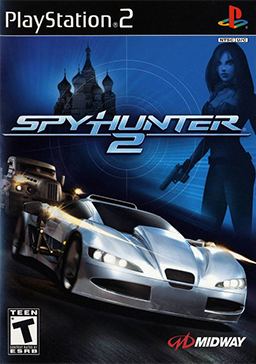
SpyHunter 2 is a video game published by Midway in 2003 for PlayStation 2 and Xbox. This game is the sequel to the 2001 remake of the 1983 game Spy Hunter. The player's first mission begins in Russia, right where the last level left off from leaving Petra, Jordan and the NOSTRA organization completely decimated initializing a sequel from the 2001 remake; he begins his cooperation with Agent Duvelle, traveling in various locations all around the planet including Russia, the United States, Asia, Switzerland and Antarctica. The weapons van is brought back again and equipped this time with an automatic turret / machine gun being that the player can utilize in extreme vehicular combat resolutions. The newly acquired Interceptor SpyHunter vehicle can enter off-road mode and transform itself into a jet-ski, a snow-mobile, a motor-tricycle, and a speedboat. The player can also choose from an arsenal of weapons inspired by James Bond 007 and Mission Impossible. Available weapons include Mines, Smoke Screen, Oil Slick, Machine Guns, Rockets, Missiles, Lasers and Cannons. The soundtrack features the song "Dark Carnival" recorded by Vanessa Carlton.
Hunter: The Reckoning is a 2002 hack-and-slash third-person shooter video game developed by High Voltage Software and published by Interplay Entertainment for the Xbox and GameCube. It is based on the tabletop role-playing game of the same name, and is part of the larger World of Darkness series. Two sequels, Wayward and Redeemer, were both released in 2003.

Midway's Greatest Arcade Hits is an arcade game compilation released for the Dreamcast, Nintendo 64, and Game Boy Advance.
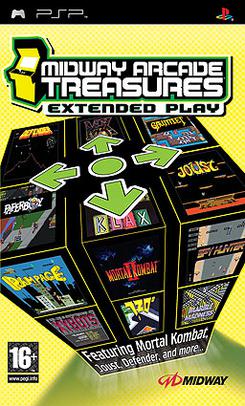
Midway Arcade Treasures: Extended Play is a video game compilation of Midway, Atari and Williams arcade game classics released in 2005 for the PlayStation Portable. Midway Arcade Treasures: Extended Play was re-released for the PlayStation Store on June 28, 2010 by Warner Bros. Interactive Entertainment due to Midway's bankruptcy, also meaning that Warner Bros. owns rights to most of the Midway, Atari and Williams arcade library after the purchase of some assets of Midway Games.

Midway Manufacturing Co. v. Artic International, Inc., 704 F.2d 1009, was a legal case where the United States Court of Appeals for the Seventh Circuit found that Artic violated Midway's copyright in their arcade games Pac-Man and Galaxian. The lawsuit was part of a trend of "knock-off" video games in the early 1980s, with courts recognizing that a video game can qualify for protection as a copyrighted audiovisual work.
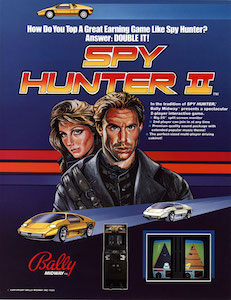
Spy Hunter II is an arcade game released by Bally Midway in 1987 as sequel to 1983's Spy Hunter. Unlike its popular predecessor, Spy Hunter II was not ported to any contemporary systems and remained obscure. George Gomez, who designed the original, was critical of the sequel made by the studio without his involvement.

George Gomez is an industrial designer, video game designer, and pinball designer who has worked for Bally, Williams, and Stern Pinball, among other companies. He has designed or contributed to several notable games, including Tron (1982), NBA Fastbreak (1997), and Monster Bash (1998).
Brian Colin is an American video-game designer, artist and animator. Among his best-known works are the coin-operated arcade games Rampage, Arch Rivals and Rampage: World Tour as well as General Chaos for the Sega Genesis game console. He is the CEO of Game Refuge, an independent video-game design and development studio with offices in Downers Grove, Illinois. He has been noted for his work in the field of bitmapped video-game graphics and animation, creating video-game sprites and tiled background graphics with a recognizable, identifiable style.

Arcade's Greatest Hits: The Midway Collection 2 is a compilation of arcade games either made by, or acquired by Midway Games for the Sony PlayStation and Microsoft Windows. This game is technically the sequel to Williams Arcade's Greatest Hits, which also had Midway acquired games included, also released on the PlayStation.